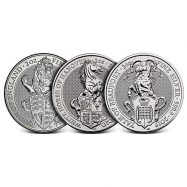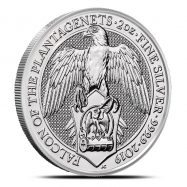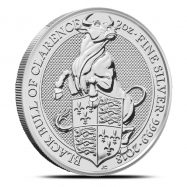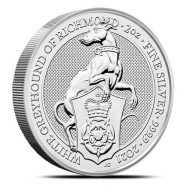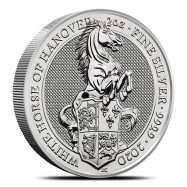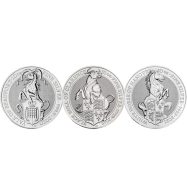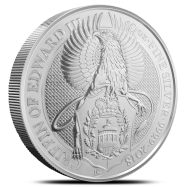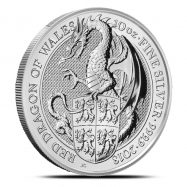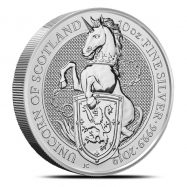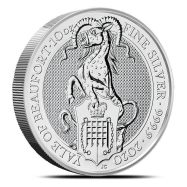Silver Queen’s Beasts at Provident Metals
The Royal Mint is home to many popular coin programs, such as the Britannia Silver and Gold series, as well as the new Tudor Beasts series of coins. One popular coin program that ran from 2016 to 2021 and issued coins in gold, silver, and platinum, was the popular Queen’s Beasts series. Learn more about Silver Queen’s Beasts, right here at Provident Metals.
History of the Queen’s Beasts Series
For the coronation of Queen Elizabeth II, ten statues were created to form a guard of honor for her entrance to Westminster Abbey. Each beast represents a part of the British monarchy, with each beast holding a shield containing a badge of arms for a Royal family associated with the Queen.
While her coronation took place on June 2, 1953, the Queen’s Beasts coin program didn’t debut until 2016. Each design was created by Jody Clark, who interestingly also designed the final effigy for the Queen as well.
Coins were issued in silver, gold, and platinum. The first coin debuted in 2016 with just a 2 oz bullion weight. This was significant as it was the first time that the Royal Mint created a silver bullion coin of this size. The popularity of the series led to a 10 oz bullion coin, and multiple proof weights debuting the following year.
2 oz coins in the series have a purity of .9999 pure silver, a face value of £2 (GBP), and arrive in protective packaging. For larger orders, tubes of 10 and Monster Boxes of 200 are also available. Proof coins are available in display boxes that come with a Certificate of Authenticity.
Designs
Notably, designs are the same for the silver, platinum, and Queen’s Beasts Gold Coins.
- Lion of England: The Lion of England dates back to the 12th century when Henry I gifted a blue shield to Geoffrey Plantagenet upon his marriage to Henry’s daughter. When Richard I took the throne, he established the Three Lions of England as the official coat of arms of the monarch.
- Griffin of Edward III: A griffin is a mythical beast with the head, wings, and front legs of an eagle, combined with the body, rear legs, and tail of a lion. This beast belonged to King Edward III.
- Red Dragon of Wales: This beast is still popular today as the Red Dragon can be seen on the Wales national flag. This heraldic beast can be traced back to the 6th century.
- Unicorn of Scotland: This mythical beast was used on the early Royal Arms of Scotland. When King James I united England and Scotland, he brought the Unicorn of Scotland with him.
- Black Bull of Clarence: Edward IV used the Black Bull of Clarence as his seal when he rose to power. This is the first of two heraldic beasts from the House of York.
- Falcon of Plantagenets: This heraldic beast is the second to be associated with King Edward III. Many monarchs from the House of York and the House of Lancaster have used a falcon in their royal symbolism.
- Yale of Beaufort: Another mythical beast, this creature is depicted with the snout and tusks of a boar, with the body of a goat. This beast came from the House of Tudor with King Henry VII.
- White Lion of Mortimer: This beast is directly connected to Edward IV, like the Black Bull of Clarence. He inherited this symbol from his grandmother who was the heiress of the Mortimer family.
- White Horse of Hanover: This beast made its way to the Royal Arms in 1714, making it among the newer beasts. King George I used this beast in the quartered shield of the Royal Arms.
- White Greyhound of Richmond: This beast comes from King Henry VII, from the House of Tudor. However, this beast can be seen on personal badges dating back to Edward III.
Purchasing Silver Queen’s Beasts at Provident Metals
Call 1-800-313-3315 to get in touch with the Provident Metals customer service team. We can be reached via email, or through our online chat as well. Don’t hesitate to reach out with any questions you may have.

